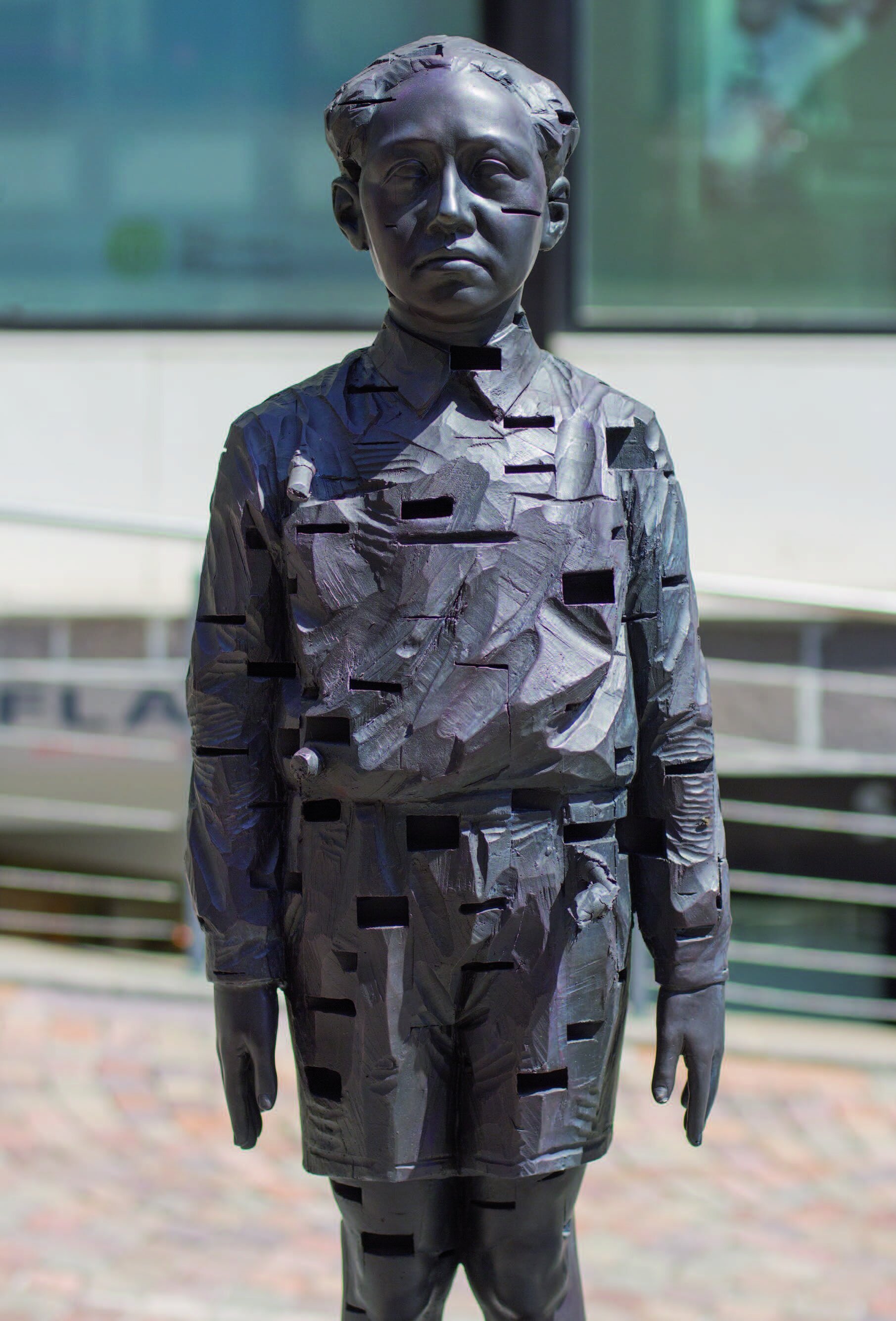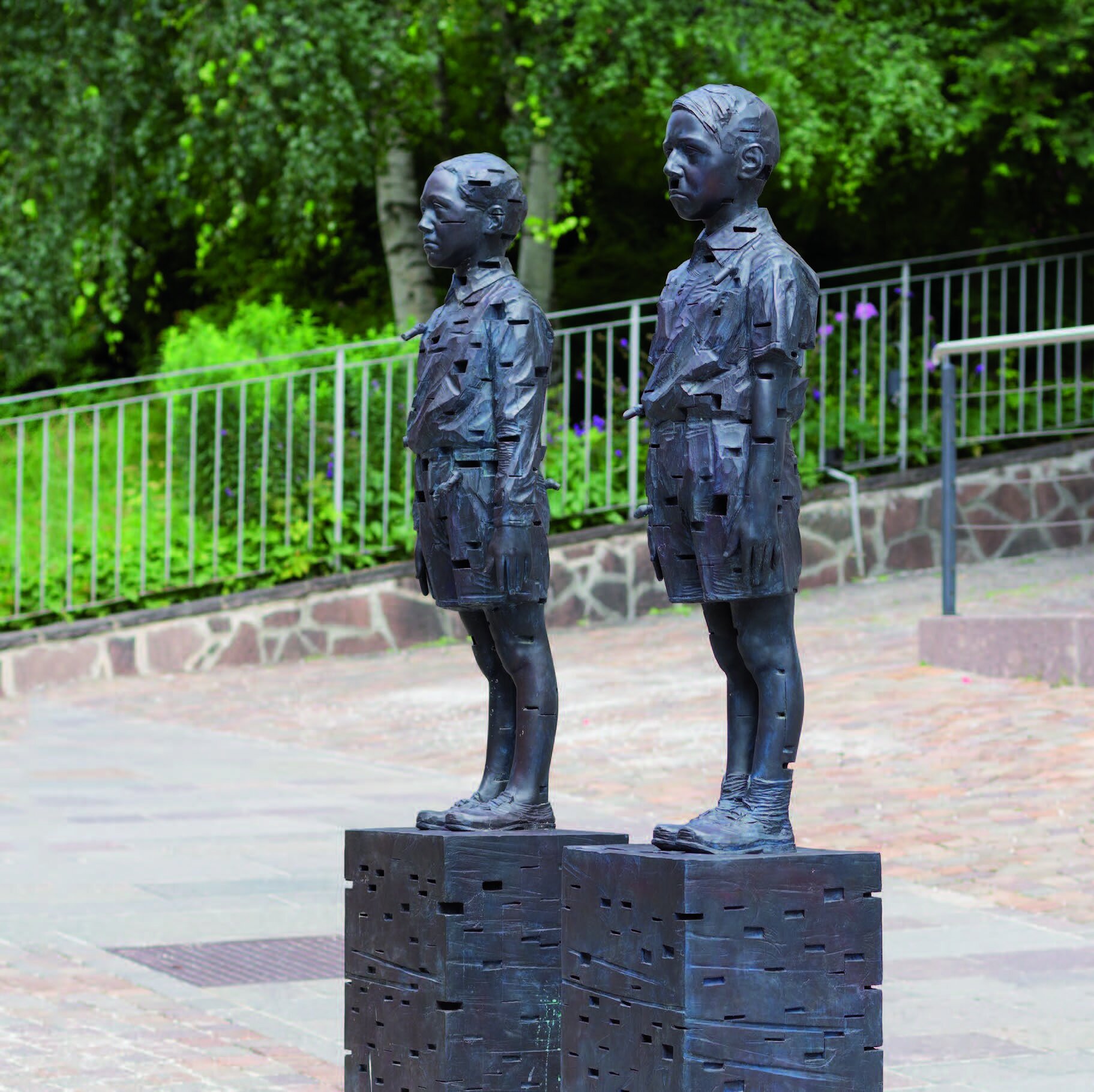
Gehard Demetz
*1972, Italy
lives and works in Val Gardena, Italy
EN
Gehard Demetz is a sculptor. His material is mostly wood, his subject the human being. When looking at the predominantly childlike sculptures, one gets the feeling that the artist strives less to depict the physical than the inner life, indeed the consciousness and subconsciousness of human existence. At first glance, the childlike nature of his creatures makes them attractive, worthy of protection, but a cool distance, an effect as if frozen, stands in the way of an emotional approach. While the body and clothing are still rough and show traces of the working process, the surfaces of the faces or hands are perfectly smooth and perfectly formed. This too makes the figures unapproachable. They are children, aware of their existence, appearing adult or precocious, perhaps also at the emotionally charged transition from child to adult. As vulnerable but also hurtful beings, their sometimes offensive poses and gestures make them seem hostile and touchingly helpless at the same time. The sculptures, made of lime wood, do not come from one block, but are assembled from many individual parts in a modular fashion. Open seams, cuboidal omissions and missing parts, as well as the volume-shaped, unfinished back sections reveal the sculptural working process of becoming. At the same time, however, they also symbolise the fractures of consciousness, the various parts and set pieces that make up personality and individuality - a process that is never complete.
Gehard Demetz irritates with bronze figures of the dictators Hitler and Mao. They, too, bear childlike facial features. The black lacquered works are casts of two wooden sculptures that Demetz created in 2007. Compared to the wood, the bronze has a different surface and feel. In addition, the casting process is made tangible: small stubbles left over from the bronze casting are still visible everywhere. These children seem small and innocent, but at the same time also sinister and threatening. Are we looking at two children or the future dictators? Looking at them gives us a queasy feeling, because the physiognomy of their faces makes it easy to recognise the future dictators and suggests that the future course of life is already determined in childhood. But perhaps it is also the banality of evil that has taken on material form through these dictators who have "shrunk" into dwarfs. But does guilt become smaller when the human being is reduced in size and meets us as a seemingly innocent child? More questions than answers arise the longer one is exposed to the sculptures. Demetz invites the viewer to approach the sculptures with his own experience and background and to find his own interpretation.
IT
Gehard Demetz è scultore. La materia prima che predilige è il legno, l’argomento principale la persona. Osservando le sue sculture, raffiguranti prevalentemente bambini e ragazzi, si ha la sensazione che l’artista non intenda rappresentare tanto la corporeità quanto piuttosto la vita interiore, la consapevolezza e anche l’inconscio dell’esistenza umana. L’aspetto infantile delle creature le rende inizialmente attraenti, bisognose di protezione, ma una fredda distanza sembra impedirci un avvicinamento emozionale. Mentre il corpo e i vestiti sono tracciati in modo piuttosto grossolano e testimoniano le fasi del processo lavorativo, le superfici dei volti e delle mani sono perfettamente lisciate e finemente lavorate nei dettagli. Anche questa caratteristica rende le figure inavvicinabili. Sono bambini consapevoli della loro esistenza, precoci o addirittura adulti, che si trovano forse nella fase di passaggio fortemente emotiva dall’infanzia all’età adulta. Sono creature vulnerabili, che al tempo stesso possono ferire; con le loro pose e i loro gesti talvolta offensivi ci appaiono minacciosi ma anche impotenti. Le sculture, realizzate in legno di tiglio, non sono scolpite entro un unico bloc-co. Esse nascono piuttosto dall’assemblaggio modulare di tanti piccoli tasselli. Cuciture aperte, lacune rettangolari e fessure imperfette narrano, insieme alla parte posteriore volumetricamente incompiuta, di un processo scultoreo in divenire. Al tempo stesso però simboleggiano anche i solchi della coscienza, i diversi elementi e le componenti che costituiscono la personalità e l’individualità, un processo che non giungerà mai a compimento.
Gehard Demetz provoca irritazione con le figure in bronzo dei ditta-tori Hitler e Mao, anch’essi rappresentati con tratti infantili. Le due opere, laccate di nero, sono calchi di due sculture in legno scolpite da Demetz nel 2007. Rispetto al legno, il bronzo possiede una superficie differente, molto diversa al tatto. Nelle due sculture è inoltre reso percepibile lo stesso processo della fusione: si notano, infatti, ancora numerose stoppie come residui dei canali di fusione per la gettata del bronzo. I bambini appaiono piccoli e innocenti, al tempo stesso però inquietanti e minacciosi. Vediamo semplicemente due bambini o però i futuri dittatori? Mentre li osserviamo sorge una sensazione sgradevole, perché la fisionomia dei volti tradisce in qualche modo già i futuri dittatori, suggerendo che già negli anni dell’infanzia è scritto il futuro corso della vita. Ma forse è anche la banalità del male che ha preso forma attraverso i dittatori “rimpiccioliti”. Si riduce anche la colpa, se l’uomo viene rimpicciolito nelle sue dimensioni e si presenta nelle fattezze di un bambino innocente? Osservando le sculture sorgono più domande che risposte. Demetz invita lo spettatore ad avvicinarsi alle sculture con la sua propria esperienza e il suo background in modo da trovare, ognuno per conto suo, una possibile interpretazione.
DE
Gehard Demetz ist Bildhauer. Sein Werkstoff ist meist das Holz, sein Thema der Mensch. Beim Betrachten der überwiegend kindlichen Skulpturen drängt sich das Gefühl auf, dass der Künstler weniger das Körperliche darzustellen strebt, als vielmehr das Innenleben, ja Bewusstsein und auch Unterbewusstsein der menschlichen Existenz. Das Kindliche seiner Wesen macht sie auf den ersten Blick anziehend, beschützenswert, doch eine kühle Distanz, eine wie eingefrorene Wirkung steht einer emotionalen Annäherung im Wege. Während der Körper und die Kleidung noch rau und Spuren des Arbeitsprozesses aufweisen, sind die Oberflächen der Gesichter oder Hände vollkommen glatt und perfekt ausformuliert. Auch das macht die Figuren unnahbar. Es sind Kinder, die sich ihrer Existenz bewusst sind, erwachsen oder frühreif wirken, vielleicht auch am emotional aufgeladenen Übergang vom Kind hin zum Erwachsenen stehen. Als verletzbare aber auch verletzende Wesen wirken sie aufgrund ihrer manchmal offensiven Posen und Gesten feindselig und rührend hilflos zugleich. Die aus Lindenholz gefertigten Skulpturen stammen nicht aus einem Block, sondern werden aus vielen Einzelteilen modulartig zusammengefügt. Offene Nahtstellen, quaderförmige Auslassungen und Fehlstellen, sowie die volumenförmig nicht ausgearbeiteten Rückenpartien legen den bildhauerischen Arbeitsprozess des Werdens offen. Gleichzeitig versinnbildlichen sie aber auch die Brüche des Bewusstseins, die verschiedenen Teile und Versatzstücke, die Persönlichkeit und Individualität ausmachen – ein Prozess, der nie vollendet ist.
Gehard Demetz irritiert mit Bronzefiguren der Diktatoren Hitler und Mao. Auch sie tragen kindliche Gesichtszüge. Die schwarz lackierten Arbeiten sind Abgüsse von zwei Holzskulpturen, die Demetz 2007 geschaffen hat. Gegenüber dem Holz hat die Bronze eine andere Oberfläche und Haptik. Zudem wird der Gussprozess erfahrbar gemacht: kleine Stoppel als Übrigbleibsel der Bronzerinnbahnen sind noch überall sichtbar. Diese Kinder wirken zwar klein und unschuldig, gleichzeitig aber auch unheimlich und bedrohlich. Sehen wir zwei Kinder oder aber die zukünftigen Diktatoren? Das Betrachten lässt ein mulmiges Gefühl entstehen, da die Physiognomie ihrer Gesichter unschwer die späteren Diktatoren erkennen lässt und suggeriert, dass bereits im Kindesalter der spätere Lebensweg festgelegt wird. Vielleicht ist es aber auch die Banalität des Bösen, die durch diese zu Zwergen „geschrumpften“ Diktatoren materielle Form angenommen hat. Doch wird die Schuld kleiner, wenn der Mensch in seinen Dimensionen verkleinert wird und uns als unschuldig scheinendes Kind begegnet? Es tauchen mehr Fragen als Antworten auf, je länger man sich den Skulpturen aussetzt. Demetz fordert den Betrachter auf, sich mit seiner Erfahrung und dem eigenen Background den Skulpturen zu nähern und eine ganz eigene Interpretation zu finden.

